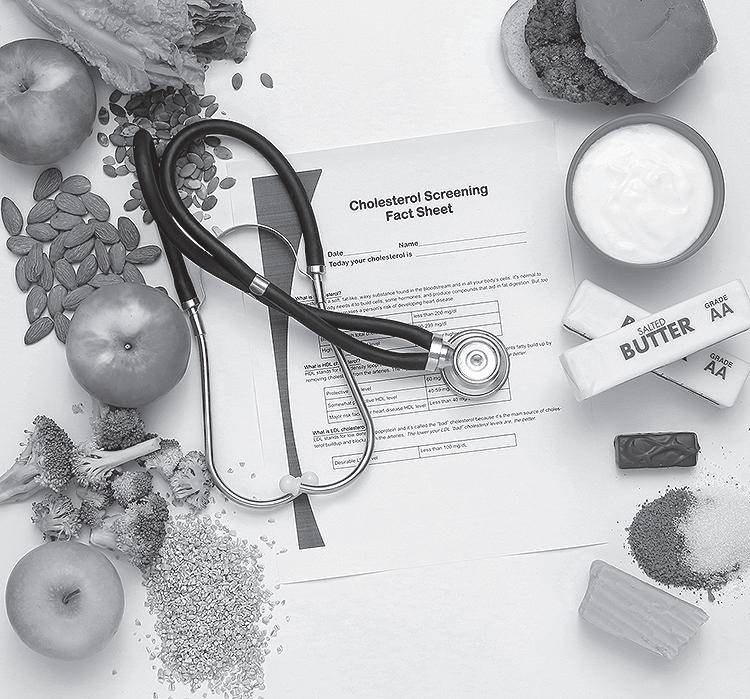HEALTH & fitness

• Resting heart rate
• Healthy weight loss
• Strength training


• Resting heart rate
• Healthy weight loss
• Strength training
Diet plays an important role in maintaining healthy cholesterol numbers. Although the level of cholesterol in a person’s blood is partly due to factors related to heredity, the foods one eats also affect cholesterol levels.
When doctors discuss cholesterol with their patients, they may refer to total cholesterol, bad cholesterol and good cholesterol. What does that mean? Total cholesterol is the combined number of cholesterol in the blood, and should be below 200. Good cholesterol is known as HDL (high-density lipoprotein) and ideally it should be above 60. Bad, or LDL (lowdensity lipoprotein) cholesterol, should be below 100, says the Cleveland Clinic. A person who has a poor lipoprotein profile may be instructed to alter their diet. Learning which foods might help is an important tool in managing cholesterol and triglyceride numbers.

Oats and more
Individuals likely have heard that oatmeal is good for helping reduce cholesterol numbers. Oatmeal has soluble fiber, which lowers LDL cholesterol by reducing the absorption of cholesterol into the bloodstream. Oat bran and other highfiber grains also are good to enjoy.
Legumes and produce
Eggplant, okra, kidney beans, Brussels sprouts, pears, apples, and more also can be effective at lowering cholesterol levels.
These foods tend to be lower in calories and saturated fats but high in soluble fiber.
Nuts
Almond, walnuts and other foods high in omega-3 fatty acids can lower cholesterol levels by raising the levels of HDL cholesterol. Nuts like almonds also are high in vitamin E, which is an antioxidant that can keep the body healthy in a number of ways. Since nuts are high in calories, it is important to eat them in moderation.
Eating fish over other meat-based protein sources helps reduce caloric intake. It also means the body gains the benefits of omega-3 fatty acids that lower LDL and triglycerides in the bloodstream.
Sterols and stanols are components of plants that gum up the body’s ability to absorb cholesterol from food, says Harvard Health. Companies add them to foods like margarine and granola bars as supplements. Roughly two grams of plant sterols a day can reduce LDL by 10 percent.
Both of these foods are good sources of fiber and also monounsaturated fats that can help improve HDL and lower
LDL levels. Substitute olive and avocado oils for lard and butter when cooking to improve cholesterol levels. Certain foods can be beneficial for
improving cholesterol numbers. Focusing on the positive can help people feel less restricted by healthy eating plans.
(METRO CREATIVE)
Understanding how the heart works can help people become more attuned to their personal health and wellness. For example, recognition of the importance of heart rate may shed light on aspects of heart health that people may otherwise never think about.
According to HealthDirect, heart rate, or pulse, is the number of times the heart beats per minute. A resting heart rate refers to the heart rate when one is relaxed, sitting down or lying down. For normal, healthy adults, a resting heart rate ranges between 60 and 100 beats per minute.
The American Heart Association indicates that resting heart rate is the heart pumping the lowest amount of blood needed because the body is not exerting
itself. A lower resting heart rate is common among people who are very physically fit — sometimes as low as 40 bpm. This results from the heart muscle being very athletic and not having to work very hard to maintain a steady beat.
Resting heart rate differs according to age. Verywell Health says babies and children have higher resting heart rates because their hearts are smaller. Resting heart rate will gradually decrease until about age 10, at which point it stabilizes through adulthood. Here’s the expected resting heart rates based on age.
0-1 month; 70-190 bpm
1-11 months; 80-160 bpm
1-2 years; 80-130 bpm
3-4 years; 80-120 bpm
5-6 years; 75-115 bpm
7-9 years; 70-110 bpm
10 years+; 60-100 bpm
Athlete; 40-60 bpm


Knowing one’s typical resting heart rate can help people stay apprised of their personal health. A lower-than normal resting heart (bradycardia) could indicate a congenital heart defect, a heart blockage, heart damage, or abnormally high blood calcium. It also may indicate hypothyroidism, hypothermia or other conditions.
A higher resting heart rate may suggest other issues, such as anemia, obesity, dehydration, fever, heart failure,
hyperthyroidism, or overconsumption of stimulants like caffeine or nicotine. Resting heart rate is not directly linked to blood pressure and is not an indication of blood pressure. Heart rate is measured on the inside of the wrist or on the artery in the neck at the base of the jaw. Pulse should be counted for 30 seconds and then multiplied by two to find beats per minute. Individuals should keep in mind that air temperature, body position, emotions, body size, and medication use can affect heart rate. Checking heart rate several times can provide a more accurate perception of resting heart rate. Any concerns should be discussed with a doctor.
(METRO CREATIVE)

Peaches are typically viewed as a sweet treat, particularly in summertime. But peaches also provide a host of health benefits, which can make anyone who enjoys a peach-based sweet treat feel a little better about their indulgence.
Peaches are rich in vitamins and minerals, including potassium. The potassium content in peaches, though moderate, is still significant, as the American Heart Association notes that potassium plays an important role in the management of high blood pressure. In addition, a 2014 animal study published in the Journal of Nutritional Biochemistry found that consumption of peach and plum juice provided protection against cardiovascular disease.
One of the keys to long-term health is the ability to maintain a healthy weight from childhood through adulthood. The Cleveland Clinic estimates that a single large peach contains just 68 calories. Peaches also do not contain any saturated fats, making them a good low-calorie snacking option that can help people maintain a healthy weight.
A report from the American Institute for Cancer Research linked fruits with a lower risk for cancers of the mouth, pharynx, larynx, esophagus, lung, and stomach. Peaches are rich in free radicalfighting vitamin C. That could explain their link to reducing cancer risk, as free radicals are unstable atoms that often contribute to cell damage that is a hallmark of cancer. In addition, MedicineNet reports that peaches are high in polyphenols, which studies have found prevent the formation and spread of cancer cells in lab tests.
Peaches also can have a positive impact on vision. According to the New Jersey Agricultural Experiment Station at Rutgers University, a medium-sized peach provides roughly 6 percent of the daily recommended value of vitamin A. That’s helpful for vision, as the American Optometric Association notes that vitamin A supports functioning of the conjunctival membranes and cornea. In addition, the AOA reports that vitamin A deficiency is the leading cause of preventable blindness in children. Peaches have a well-earned reputation as a sweet treat. However, the powerful peach is more than just a post-meal palate cleanser, and in fact can play a vital role in promoting long-term health.
(METRO CREATIVE)
Many people recall the slogan “Milk, it does a body good.” But as different health fads have emerged since that slogan was first uttered, including an increased availability of dairy alternatives, dairy has been somewhat pushed aside, leaving many people to question if it is a friend or foe.
According to Vasanti Malik, a nutrition research scientist with the Harvard T.H. Chan School of Public Health, dairy isn’t necessary for maintaining optimal health for humans. However, it is one of the best and easiest ways to get ample amounts of vitamin D, protein and calcium, each of which keeps vital organs, muscles and bones functioning properly. Here’s a deeper look at dairy in the average diet.
Dairy products consist of a variety of products that are from mammals, including cows, goats and sheep. These include milk, yogurt, cheese, kefir, ice cream, butter, ghee, cream, cream cheese, sour cream, whey products, and casein. Dairy products are often categorized as “regular,” “whole,” “reduced fat,” “low-fat,” or “skim.” These characterizations indicate the fat content in a given item.
Dairy products are nutrient-dense and great sources of protein, calcium and vitamins. Protein builds and repairs muscle tissue; carbohydrates in milk provide energy; and calcium and phosphorous can help strengthen bones and teeth. Vitamin D helps promote the absorption of calcium. Dairy also contains riboflavin, vitamin A, pantothenic acid, potassium and niacin. One eight-ounce serving of milk contains the recommended daily values of these nutrients based on guidelines from the U.S. Food & Drug Administration.

Dairy protein and calcium may play critical roles in bone health and density, helping to reduce the risk for osteoporosis, states the Dairy Alliance. Eating and drinking foods rich in calcium may offset a possible protein-calcium loss that occurs with aging, thus protecting bone health.
Some people avoid dairy because of perceptions that it is bad for cardiac health. A report presented at the 2018 Congress of the European Society of Cardiology that looked at 20 studies involving around 25,000 people found no association between the consumption of most dairy products (including whole fat varieties) and cardiovascular disease. The only exception was milk, but the results showed one would have to drink almost a liter of milk a day for a higher risk of cardiovascular disease. Still, the American Heart Association recommends adults choose fat-free or low-fat dairy products whenever possible. Also, a 2018 study published in the British Journal of Nutrition found men who ate plenty of fermented dairy products like yogurt and cheese had a smaller risk of coronary
artery disease than men who ate less. Additional benefits of dairy include a reduced risk of childhood obesity and an improvement in body composition and weight loss during energy restriction in adults, according to a 2016 report in the
Journal of Food and Nutrition Research. Dairy provides many health benefits. People concerned about their overall health should work recommended dairy servings into their daily diets.
(METRO CREATIVE)
EDITOR IN CHIEF: Heather Ruenz
SECTION DESIGNER: Jen DeGroot
CREATIVE DIRECTOR: Heidi Schulz
SPECIAL SECTIONS
ADVERTISING: Vicki Vanderwerff For














Sleep is an often unsung hero of overall health. Diet and exercise get their fair share of glory, but without a good night’s rest, even the most physically active, nutritionconscious individuals are vulnerable to a host of ailments and illnesses.
According to the U.S. Department of Health and Human Services, most adults need seven or more hours of sleep on a regular schedule each night. Athletes may even benefit from additional sleep. In fact, a 2011 study published in the journal Sleep examined the effects of sleep extension on the athletic performance of collegiate basketball players. That study found that athletes asked to extend their normal sleep times exhibited faster sprint times and increased free-throw accuracy and a reduction in fatigue at the end of the sleep extension period.
Improved athletic performance is not the only way that sufficient sleep benefits the human body.
The Mayo Clinic notes that the immune system releases proteins called cytokines during sleep. The release of certain cytokines needs to increase when individuals are experiencing infections or inflammation, which is one reason why doctors often recommend extra sleep to sick patients. Without adequate sleep, the immune system may not produce enough cytokines, and that can increase the frequency with which individuals get sick.

The Harvard T.H. Chan School of Public Health reports there is mounting evidence to suggest a link between
insufficient sleep and weight gain and obesity. Studies exploring this potential link have been conducted for decades and have examined how sleep affects people of all ages and genders. At the 2006 American Thoracic Society International Conference, researchers who had tracked women’s sleep habits for 16 years found that those who slept just six hours per night were 12 percent more likely to experience major weight gain than women who slept seven hours per night. Experts aren’t entirely sure why this relationship exists, but the
results of various studies support the idea that insufficient sleep is a potential catalyst for gaining weight.

The Centers for Disease Control and Prevention notes that insufficient sleep has been linked to the development and management of various chronic diseases. For example, the CDC indicates that insufficient sleep has been linked to an
increased risk for type 2 diabetes. In addition, the CDC reports that instances of hypertension, stroke, coronary heart disease, and irregular heartbeat are more common among individuals with disordered sleep than they are among people without such sleep abnormalities.
Sleep is not often mentioned alongside diet and exercise as a vital component of overall health. But a good night’s rest is no less vital to long-term health than a healthy diet and physical activity.
(METRO CREATIVE)Childhood obesity poses a serious threat to the long-term health of kids across the globe. According to the World Health Organization, 39 million children under the age of five were overweight or obese in 2020. That means that tens of millions of kids across the globe are facing a serious and potentially chronic health problem before they even begin kindergarten.
The data pertaining to childhood obesity is undoubtedly alarming, but the good news is that obesity is preventable. Parents can provide nutritious foods for children and help them establish healthy eating habits at an early age, which could lay the foundation for a lifelong commitment to eating right.
One of the issues parents may encounter when planning kids’ diets is foods that seem healthy but are actually hidden sources of sugar. That’s a big problem, as Johns Hopkins Medicine notes that excess sugar consumption is associated with an elevated risk for cardiovascular disease. Sugar consumption has long been linked to obesity, which is one reason why the WHO recommended in 2015 that individuals get less than 10 percent of their daily calories from sugar.
On the surface, it may seem simple for parents to heed that warning from the WHO. However, various foods and beverages, including ones kids typically love, are hidden sources of sugar. Identifying those foods and avoiding them or choosing versions that are not high in sugar can help kids maintain healthy weights.
Parents may fondly recall overindulging in cereals with popular cartoon mascots on the box as kids. No matter how much nostalgia such memories may generate, parents must resist the temptation to recreate them for their own children. That’s because many popular cereals marketed to children are loaded with sugar.
However, even seemingly healthy cereals could be loaded with sugar. Read nutrition labels before buying cereal for kids. Johns Hopkins Medicine recommends choosing cereals with 10 to 12 grams or less of sugar per serving.
Sugar-laden beverages like sodas, certain juices and even some flavored waters increase kids’ risk of being overweight or obese. Encourage youngsters to drink more water and only serve sugary beverages on special occasions.
Here’s another food that appears healthy on the surface but could be anything but. WebMD notes that a one-cup serving of mandarin oranges in light syrup contains right around 39 grams of sugar. Offer fresh fruit in lieu of packaged fruits.
Many kids look forward to nights when pasta is the main course at the dinner table. But even parents who serve whole grain pastas could be unknowingly serving up a sizable amount of sugar if they aren’t careful about which sauce they buy at the store.

Some pasta sauces contain as much as 12 grams of sugar per half-cup serving. Barbecue sauces also tend to be high in sugar, which underscores the importance of reading labels before serving up saucy meals.
Childhood obesity is preventable, especially when parents learn to identify hidden sources of sugar that could be putting kids’ healthy in jeopardy.
(METRO CREATIVE)
Maintaining a healthy weight promotes long-term health. Being overweight or obese are risk factors for various conditions, including type 2 diabetes and cardiovascular disease. The World Health Organization reports that the worldwide obesity rate has tripled since 1975. In 2016, more than 1.9 billion adults were overweight. Of these, more than 650 million were obese. Health issues related to obesity are largely preventable. Losing weight in a healthy manner is essential for safe and lasting results. Individuals aspiring to lose weight can follow these guidelines on what to do and what not to do.
DO add lean protein sources to your diet. Healthline indicates the body burns calories when digesting and metabolizing protein, so a high-protein diet can help to shed up to 80 to 100 calories per day. Protein also helps you to feel full, reducing the propensity to overeat.
DON’T get hung up on numbers early on.
The Centers for Disease Control and Prevention advises that even modest weight loss of 5 to 10 percent of your total body weight is bound to produce health benefits, such as improvements in blood sugar levels, cholesterol and blood pressure. Start small and gradually build up.
DO eat at least four servings of vegetables and three servings of fruits daily. Produce contains an abundance of vital nutrients and is often fiber-rich and low in calories, which helps you to feel full.
DON’T overlook the impact of beverages on weight loss. The calories in sugary beverages, including some all-natural fruit juices, can
add up quickly. Stick to water, tea or other unsweetened beverages to help with weight loss.
DO get moving more. The Mayo Clinic notes that while it is possible to lose weight without exercise, getting moving can help burn off the excess calories you can’t cut through diet alone. Exercise boosts metabolism and benefits mood and strengthens muscles and the cardiovascular system as well.
DON’T go shopping while hungry. If you do, you may make impulse buys that compromise healthy eating plans.
DO speak with a doctor if you are vetting diet and exercise plans. A healthcare professional can assist you by indicating if a particular diet or fitness routine is acceptable for your age, goals and current health status.
DON’T forget to track eating. Most healthy diets involve some sort of calorie-counting, whether they actually require you to document your intake or use a formula to attribute ÒpointsÓ or another measure related to what you eat. Writing or tracking the foods and beverages you consume will provide the most honest assessment of habits that could affect weight loss.
DO include foods you enjoy. Completely restricting access to occasional treats may cause you to resent healthy eating, which can derail weight loss goals. The principle of moderation can apply to healthy weight loss as long as you account for the more calorie-dense foods.
Do you struggle with starting or maintaining a fitness routine? Don’t worry, you’re not alone. While most of us know that exercise is beneficial, fitness can be daunting, especially if you’re over 65 and want to be sure that you work out in a way that is safe and effective.
The good news? Physical activity is key to maintaining health and mobility as you age, and if you are 65 or older, the right Medicare Advantage Plan can provide tools and resources to help you get off the couch. If you just need a little motivation to reengage in your fitness and social routines or would like to start a new one, there are more choices than ever in exercise and wellness options.
A balanced diet and exercise, which includes a combination of aerobic activities and strength training, is necessary to maintain long-term health.
According to the Centers for Disease Control and Prevention, regular physical activity is one of the most important things older adults can do to protect their overall health. Exercise helps to delay or prevent many of the conditions that come with age. Adults ages 65 and older should aim for the recommended 150 minutes a week of moderate-intensity activity, such as brisk walking, and at least two days of activities that strengthen muscles.
When it comes to muscle strengthening, seniors can follow these safety guidelines as they embark on their strength-training journeys.

Get the green light to proceed with an exercise regimen before beginning by having a discussion with your general practitioner about your fitness goals. Your doctor can recommend strategies that are safe and point
out any exercises that may compromise your overall health.
Anyone new to strength training, which is sometimes known as resistance training, can start out slowly, even using just body weight, to provide resistance. Resistance exercises can include squats, crunches, modified pushups, planks, and lunges.
When you’re ready to move on to something else, consider resistance bands as an alternative to free weights. The bands can help you develop good form before introducing weight. Good form is key to avoiding injury.
Working with a certified personal trainer can help you learn how to use free weights and strength-training machines correctly. A trainer also can create a routine that includes the right number of sets and repetitions to gradually build and maintain muscle mass. If you decide against hiring a trainer, gym staff members may guide you through equipment and demonstrate proper form.
Strength training with a friend or family member can provide motivation and keep you on target to meet your goals.
Your first strength session should only last 10 to 15 minutes, according to Tiffany Chag, C.S.C.S., a strength coach at the Hospital for Special Surgery in New York. This enables you to gauge soreness. Wait until soreness abates before beginning your next session if you are new to strength training.
Strength exercises are a vital part of maintaining health as a senior. Such exercises help maintain muscle mass and also improve balance and bone health.

No matter your age, the ongoing pandemic has caused tremendous changes in our lives, including an increase in physical and mental health issues because of social isolation. Many seniors were understandably cautious due to a heightened health risk and experienced a greater disruption of trusted routines. More good news? We continue to see a return to our lifestyles and activities.
A recent nationwide poll by Tivity Health, a leading provider of healthy lifestyle solutions, including SilverSneakers®, the nation’s leading community fitness program designed for older adults, shows that seniors no longer just work out at the gym or home, but enjoy the freedom to exercise how and where they please: indoors, outdoors, at the gym or community center, together or alone, in-person or virtual.
The poll also found that over the last few months, 78% of seniors have engaged in some type of physical activity, the highest proportion in months. More seniors are engaging in activities that bring them joy and can include a variety of movements - walking, household chores, gardening, hiking, etc. By identifying how the past few years have unsettled these daily routines, we can take steps to help older adults re-energize and re-engage in healthy activities that are enjoyable and encourage valuable social connections.
By joining forces with Apple Fitness+, the award-winning fitness and wellness service designed to be welcoming to all, SilverSneakers members in participating health plans will soon have access to Apple Fitness+, with workout types from Strength to Yoga, guided mediations, and more at no additional cost.
Programming allows members to exercise where they want, when they want with world-class workouts and fitness programming curated for a range of skill levels and interests.
“We know that fitness isn’t one size fits all, especially with today’s dynamic senior population,” said Richard Ashworth, president and CEO of Tivity Health. “Seniors need a variety of options for physical activity that fit their lifestyles. Our partnership with Apple Fitness+ offers fitness for all skill levels, interests and goals including a wide array of content presented by expert instructors and celebrity guests.”
The fitness industry is changing. According to the International Council on Active Aging, a large and growing number of products and services are being developed to allow people to fully enjoy the gift of a longer life, which requires a foundation of good health. Exercise remains critical for seniors to maintain a healthy immune system that’s able to fight off disease and consistent exercise can improve balance and strength and help prevent falls.
One trend the pandemic saw was the rise of digital and virtual care, and it’s here to stay. About one in four seniors are currently using a device to monitor their health and well-being, and the use of video calls to socially connect with friends and family has steadily increased in the past few months.
“As a fitness instructor, I see firsthand how exercise can change a person’s life. But fitness is more than just a workout,” said Jen Burgmeier, 2022 SilverSneakers Instructor of the Year. “I have SilverSneakers members who attend classes both in-person and virtually, and I love that they have a choice to work out when and where they want. One of my members recently said that ‘the laughter and camaraderie coming through her computer screen makes you feel like you could conquer anything!’ I get so much joy out of seeing them take meaningful steps to improve their health and watch them fall in love with SilverSneakers.”








